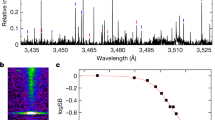Abstract
The heavy-ion analyser PICCA1,2 on the Giotto spacecraft was used to determine the composition and energy distribution of positively charged ions in the coma of comet Halley. Here we argue that the distinct peak observed at mass 39 AMU is due to the aromatic cation C3H3+ (cyclopropenyl). Laboratory mass spec-troscopy of unsaturated hydrocarbon-chain molecules and aromatics yields large intensities of mass-to-charge ratio (m/z) 39; the spectra of the aromatic molecules also indicate the presence of C4H3+ (m/z =51) and C5H5+ (m/z =65). These latter products are not seen in the PICCA data, suggesting that in the cometary environment unsaturated hydrocarbon chains predominate over aromatics. We suggest that the progenitor of the hydrocarbon chains (which are apparently the parents of the C3H3+ ion) are the 'CHON' dust particles observed around the comet3; the C3H3+ ion may also be one of the parent molecules of C3, which is a common feature of cometary spectra4, although its origin has remained obscure.
This is a preview of subscription content, access via your institution
Access options
Subscribe to this journal
Receive 51 print issues and online access
$199.00 per year
only $3.90 per issue
Buy this article
- Purchase on Springer Link
- Instant access to full article PDF
Prices may be subject to local taxes which are calculated during checkout
Similar content being viewed by others
References
Korth, A. et al. Nature 321, 335–336 (1986).
Korth, A. et al. J. Phys. E 20, 787–792 (1987).
Kissel, J. et al. Nature 321, 280–282 (1986).
A'Heam, M. F. in Comets (ed. Wilkening, L. L.) 448 (Univ. of Arizona Press, Tucson, Arizona, 1982).
Neubauer, F. M. Astr. Astrophys. 187, 73–79 (1987).
Schwenn, R. et al. Astr. Astrophys. 187, 160–162 (1987).
Mitchell, D. L. et al. Eur. Space Ag. SP-250, 203–205 (1986).
Silverstein, R. M., Bassler, G. C. & Morrill, T. C. Spectroscopic Identification of Organic Compounds 41 (Wiley, New York, 1974).
Mitchell, D. L. et al. Adv. Space Res. (in the press).
Schutte, W. A. thesis, Univ. of Leiden (1988).
Giard, M. et al. Astr. Astrophys. 201, L1–L4 (1988).
Spiteller, G. Massenspektrometrische Strukturanalyse organischer Verbindungen (Verlag Chemie, Weinheim, 1966).
McLafferty, F. W. Interpretation of Mass Spectra. (Univ. Science Books, Mill Valley, California, 1980).
Kissel, J. & Krueger, F. R. Nature 326, 755–760 (1987).
Murad, E. & Bochsler, P. Nature 326, 366–367 (1987).
Mendis, D. A., Houpis, H. L. F. & Marconi, M. L. Fundam. cosmic Phys. 10, 1–380 (1985).
Krankowsky, D. et al. Nature 321, 326–329 (1986).
Marconi, M. L. & Mendis, D. A. Astrophys. J. 330, 513–517 (1988).
Lämmerzahl, P. et al. Astr. Astrophys. 187, 169–173 (1987).
Author information
Authors and Affiliations
Rights and permissions
About this article
Cite this article
Korth, A., Marconi, M., Mendis, D. et al. Probable detection of organic-dust-borne aromatic C3H3+ ions in the coma of comet Halley. Nature 337, 53–55 (1989). https://doi.org/10.1038/337053a0
Received:
Accepted:
Issue Date:
DOI: https://doi.org/10.1038/337053a0
This article is cited by
-
Direct IR Absorption Spectra of Propargyl Cation Isolated in Solid Argon
Scientific Reports (2018)
-
Cosac, The Cometary Sampling and Composition Experiment on Philae
Space Science Reviews (2007)
-
Comets
The Astronomy and Astrophysics Review (1993)
-
Representative abundances of a few positive ions in the innermost coma of comet Halley
Earth, Moon, and Planets (1993)
Comments
By submitting a comment you agree to abide by our Terms and Community Guidelines. If you find something abusive or that does not comply with our terms or guidelines please flag it as inappropriate.



